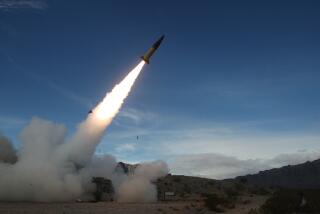In Soviet Arms Talks, U.S. Takes Troubling Stance on ‘Stealth’ Missiles
CAMBRIDGE, MASS. — The United States and Soviet Union are again involved in diplomatic negotiations with momentous implications for the security of our country.
On one key issue, the Bush Administration has so far taken a position not only open to serious challenge, but which could put our entire national security planning at risk.
The objective of the Strategic Arms Reduction Talks, commonly known as START, is to negotiate a reduction in the number of strategic nuclear weapons of each superpower, along with other measures designed to reduce the likelihood that such weapons would ever be used. Unfortunately, although our country will almost certainly be better off with a START treaty than without one, it is possible that START may fail to limit a new, troubling and most dangerous nuclear-weapon system--the nuclear-armed sea-launched cruise missile, or SLCM.
The SLCM is a nuclear-armed missile much like a miniature pilotless jet airplane. When launched from the torpedo tube of a submerged submarine, a rocket motor propels it to the ocean surface and into the air. After it reaches a high enough speed, the rocket motor falls off, wings that are folded into its body are deployed, a miniature jet engine is turned on and it begins jet-powered flight toward its target.
In part because SLCMs are so small and move relatively slowly, they are maddeningly difficult to detect with radar or other types of sensors. They are also difficult to detect because they can avoid radar by flying close to the ground, do not emit much heat or make large amounts of noise, and if observed, might well be confused with small aircraft. For all practical purposes, current U.S. early-warning systems have no ability to detect the launch, approach and overflight of SLCMs.
Thus if the Soviet navy took reasonable operational precautions, a single submarine off our coast could potentially launch tens of SLCMs without our knowledge. Some of these SLCMs could fly circuitous paths to nearby targets while others fly more directly to distant targets. All missiles could then arrive at their targets within a minute or so of a predetermined attack time.
How seriously should we take this threat of sneak attack from Soviet SLCMs? Its importance or plausibility should not be exaggerated. It would not be easy for the Soviets to pull off such an attack. Depending on circumstances, their submarines might have to spend hours, days or even weeks taking up positions for a properly timed attack, an operation that could hardly appeal to Soviet leaders if they were attacking in the first place because they feared imminent U.S. attack. It can therefore be argued that such worries about an SLCM sneak attack are overstated and inappropriate.
Yet my experience with similar military planning concerns leads me to predict that our military will take the threat of such a sneak attack seriously. They will adapt U.S. operations to attempt to compensate for it, they will spend money to defeat it and they will adjust assessments of U.S. nuclear-force capabilities to take it into account. Their concerns will also grow as Soviet SLCMs improve in stealth and range.
This situation closely parallels that of 20 years ago when we failed, during the Strategic Arms Limitation Talks, to stop the Soviets from placing multiple warhead payloads on their gigantic land-based missiles. This failure is a tragic example of a national security decision that decreased America’s military security. The record of Soviet and U.S. discussions during SALT suggests that this objective might well have been within the reach of U.S. negotiators. However, the Joint Chiefs of Staff could not be convinced that such an arrangement was in the military interest of the United States, and a previous decision in the Johnson Administration to test U.S. multiple warhead missiles created a labyrinth of obstacles that could not ultimately be overcome by those involved with the negotiations.
A consequence of these oversights was a vast expansion in the number of highly accurate Soviet land-based warheads. Today our military planners worry deeply about the possibility that the Soviets could use all these additional warheads to preemptively destroy our land-based missiles. Unlike most of the unpredictable events that befall us in our precarious attempts to chart our nation’s future, this outcome was predictable and could well have been prevented.
Although images of thousands of Soviet ballistic missile warheads coasting over the North Pole toward our land-based missiles seem both fantastic and beyond comprehension, our country’s military establishment has been in near crisis over this theoretical possibility for more than a decade. We have tried to solve the vulnerability problem of our missiles with proposals to build thousands of shelters in which a few missiles might be hidden, a system called Multiple Protective Shelters; by bunching our missiles together so closely that warheads attacking one hardened missile shelter would damage other attacking warheads, a system called Closely Spaced Based MX, and now we are arguing over the merits of deploying a new mobile small missile that has the astonishing virtue that it does not have multiple warheads.
The United States has not yet finished deploying the B-1 Bomber, a program that will have a total cost well in excess of $30 billion, and there are news reports that suggest that the B-2 bomber program could well cost more than $70 billion. Yet a single properly positioned SLCM-armed Soviet submarine operating off our coast will hold the potential to destroy most, if not all, of these forces on the ground--and without warning. Hence, one of the major objectives of START should be to negotiate measures that will protect our investment in these forces.
The Soviet Union has similar incentives to negotiate with the United States to eliminate these troublesome weapons. They also could be susceptible to a nuclear sneak attack from U.S. SLCMs. Launched from a single submarine near the northern coast of European Russia, nuclear SLCMs could destroy all Soviet early-warning radars in European Russia. In addition, bomber bases and command posts throughout European Russia, and even Moscow itself, could be readily destroyed in such a SLCM sneak attack.
The Soviets have reportedly expressed concerns about SLCMs in the START talks, and have proposed that compliance with SLCM limitations be verified by using a system of monitoring comparable with that now being used to verify the Intermediate Nuclear Forces Treaty. Verification procedures proposed by the Soviets would include continuous on-site inspection and monitoring of ships at nuclear loading facilities. However, the United States has so far been unwilling to discuss the issue, arguing that controls on nuclear SLCMs cannot be verified.
It is highly unlikely that this argument for the U.S. position is correct. Although the nuclear sea-launched cruise missile is small, it is one of the largest objects loaded onto U.S. warships. It is sealed with its warhead in a canister that is not supposed to be accessible at sea, and it has a warhead that can be detected by nearby monitoring equipment, assuming proper provisions for inspections are negotiated.
Once nuclear SLCMs are loaded into their launchers on U.S. surface ships or submarines, there is no equipment for removing them or tampering with them while the ships are at sea.
Hence a system of verification provisions that included monitoring of loading docks where naval nuclear missiles are handled, and occasional challenge inspections of warships, has great potential to make it possible for both sides to verify agreed-upon controls on nuclear-armed SLCMs.
The stunning changes in Soviet diplomatic attitudes that have accompanied the rise of President Mikhail S. Gorbachev, and the persistence of the Reagan Administration, have put our START negotiators in a most enviable position. They can now negotiate a web of intrusive and revealing inspection procedures that should make it possible to uncover subtle inconsistencies in Soviet weapons-handling procedures. There is every reason to believe that verification provisions designed to detect very small numbers of nuclear-armed SLCMs are not beyond the reach of START, or a follow-on START treaty.
If the Bush Administration does not address the issue of nuclear-armed SLCMs in START, many long-sought and vital objectives of U.S. security planning could well be put in jeopardy.
More to Read
Sign up for Essential California
The most important California stories and recommendations in your inbox every morning.
You may occasionally receive promotional content from the Los Angeles Times.










